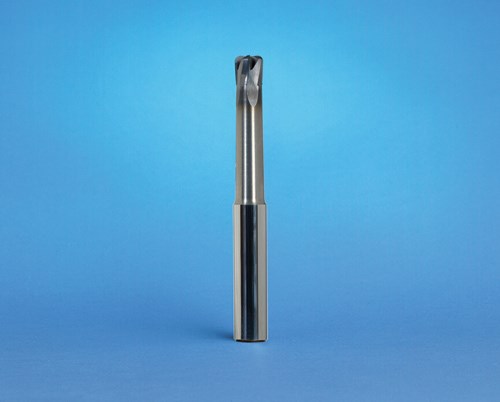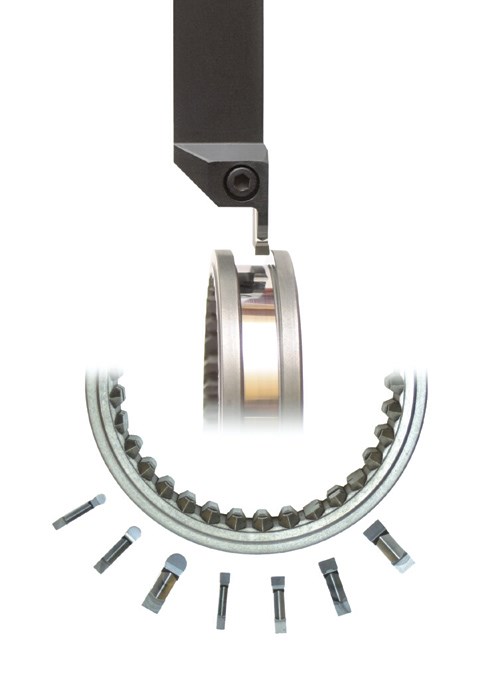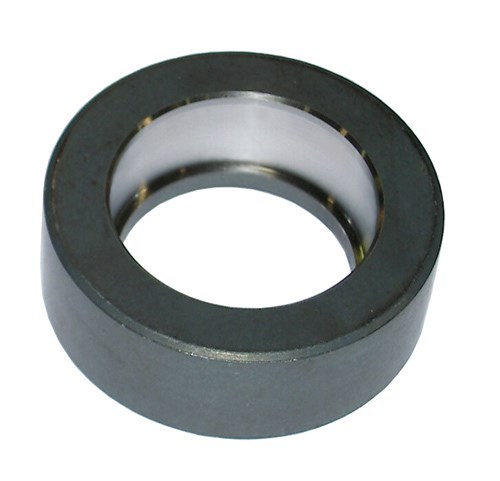New Use of Hard Machining Can Replace EDM
Throughout the past decade, new developments in cutting tools and machining center technologies have opened the door for milling of complex component shapes and geometries in hardened materials previously accomplished through Electrical Discharge Machining.
Throughout the past decade, new developments in cutting tools and machining center technologies have opened the door for milling of complex component shapes and geometries in hardened materials
(55 Rc and above) that were previously accomplished through Electrical Discharge Machining (EDM). Although EDM is one of the most accurate manufacturing processes available for intricate shapes, there are some less-than-desirable issues that come with it.
For example, production of a typical part requires 4 to 5 electrodes because of wear. The electrodes are resharpened as they wear, but that procedure takes place outside of the machine and is, therefore, time-consuming and costly. EDM work can also be messy because of the dielectric fluid and water that is used. This, in turn, triggers environmental concerns. Overall, when compared with machining, it is a time-intensive process.
Where manufacturers didn’t have much of a choice in the past, today’s machine tools are capable of following complicated tool paths at higher feed rates. When these machines are used in conjunction with solid carbide end mills, such as Seco’s Jabro JHF180 developed for high feed milling of hardened steels, shops can apply a high feed methodology to produce shapes previously thought achievable only through EDM. Many shops machining hard material are finding they now have a choice as to which production process to implement.
What is really exciting in the hard machining area today is the development of hard threading. In hardened materials, it has traditionally been difficult to produce a thread, especially one of high quality. In work materials of either cast iron or steel that is 55 Rc or above, Seco Tools Inc. has found innovative ways to produce high quality threads in several thread forms using its solid carbide coated thread mills. In one example, it took about 1 to 1.5 hours to produce a 10 × 24 thread using an EDM technique, whereas this new thread mill process created the thread in about 45 seconds delivering better surface quality and dimensional control.
When thread milling, it is important to have a rigid setup and minimal runout. This is highly dependent on the workholding method. In these applications, heat shrink tooling provides the highest level of concentricity and lowest total runout.
The key to hard threading is the use of either coated solid carbide or PCBN — polycrystalline cubic boron nitride inserts. Cubic boron nitride is a sintered product made from one of the softest materials known — hexagonal boron nitride. This soft, white powder is subjected to intense temperature and pressure in a die and anvil reaction/synthesis tooling process, yielding cubic boron nitride grit—the second hardest substance known to man.
New developments in PVD coatings using advanced materials such as Ti(Si)N have improved these PCBN inserts by helping keep the cutting edge sharper for a longer period of time. Coatings increase wear resistance by lowering the coefficient of friction, thus reducing the heat at the cutting edge. They enhance surface lubricity, making chip removal faster and allow higher machining speeds. Coatings aid in preventing chemical reactivity between the workpiece and the tool, leading to edge build-up.
Secomax is a range of high performance cutting tool grades based on PCBN. These grades are formulated and specifically developed for machining hardened steel, pearlitic cast iron, hard iron and superalloys. While PCBN tools can cost as much as 10 to 20 times more than conventional tools, studies have shown them to be 10 to 300 times more effective in terms of overall productivity and tool life.
Another benefit of applying PCBN inserts is that hard turning can replace grinding applications. More flexibility, faster tool changes and longer tool life contribute to lower machining costs, higher productivity and better part quality, far outweighing the initial cost of (PCBN) tools.
Recently, Seco broke new ground by developing a process enabling single point threading in hardened materials, which previously would have relied upon EDM. Threads can be produced in almost any OD diameter, as well as in ID diameters of 2.5 inches. By applying a hard threading methodology on a hardened steel (65 Rc) bearing ring liner, the component, using a single-point Acme CBN insert, was first turned and then threaded — all on the same machine. Previously, the process would have gone from a grinder, which is traditionally more expensive than a CNC lathe, to an EDM machine, and taken about 1 to 1.5 hours versus the 3 to 4 minutes required by hard threading.
And, hard threading is not only limited to larger diameters. For smaller sizes, Seco has worked on applications that first apply a circular interpolation process using a solid carbide end mill — JHF180 — to create the initial hole. After that, standard carbide thread mills have been used to create 10 to 24 threads in diameters from 0.150 inch and larger. This technique has been used successfully on materials as much as 70 Rc with standard tools. Requirements include a very solid and rigid machine setup.
By combining helical interpolation with a threading process on the same piece of equipment, a 2-inch deep hole was created in about a minute, followed by about 40 seconds for threading. If this same component relied upon EDM, it would have taken 1.5 hours and consumed a minimum of three
electrodes.
Seco admits that the process takes a little debugging and failure analysis. But, that up-front work is easily offset by the productivity and quality gains, especially when you have a knowledgeable tooling supplier that can help troubleshoot quickly and effectively.
Given today’s highly competitive market, suppliers must respond to customer demands more quickly through application of more efficient processes that increase productivity. Having a choice of manufacturing methods allows manufacturers to select the most cost-effective strategies rather than being limited with one choice of technology. Developments in both EDM and machining methodologies will continue to open the door to new and more efficient component production.
Related Content
Micromachining Fundamentals
A number of elements must come together to establish an effective process for machining at a micro level. Here we consider four.
Read MoreData Matrix Codes Offer Cutting Tool Traceability
A company’s quest to discover errors in a manufacturing process has led to printing data matrix codes on its cutting tools that provide a wealth of information for both the user and this cutting tool manufacturer.
Read MoreShop Sets its Sights on Precise Tool Alignment
A Wisconsin shop has found that visual tool alignment technology has improved tool life and surface finishes for its Swiss-type lathes while increasing throughput as well.
Read MoreMaking Micro Threads
Production of micro threads can be challenging, but using the most suitable tools for a given application can simplify the task.
Read MoreRead Next
Tooling Up For Hard Turning
Hard turning isn’t hard to do. However, it does require an understanding of the process dynamics and a systematic approach to the tooling involved. This article looks at how proper preparation will deliver consistent, predictable hard-turning results.
Read MoreHard Milling By The Numbers
Here are some speeds, feed rates and depths of cut for a productive hard milling process.
Read MoreDo You Have Single Points of Failure?
Plans need to be in place before a catastrophic event occurs.
Read More














.png;maxWidth=300;quality=90)











